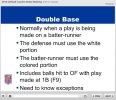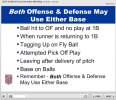cz fastpitch fan
Member
- Joined
- Jun 18, 2014
- Messages
- 452
- Reaction score
- 0
- Points
- 16
After a dropped third strike, the catcher's first desire should be to tag the batter while in the box or right at the plate area. However, sometimes the situation just simply requires a throw to 1B. There are some coaches (myself included) who believe that a ball in foul territory should be thrown in FOUL territory with the fielder at 1B setting up way in advance (so as not to even remotely obstruct the runner) with her RIGHT foot on the ORANGE bag.
Conversely, if the ball is in fair, or directly in front of the catcher and setting up in fair territory is quicker than setting up in foul, then the fielder covering 1B should set up in FAIR territory with the LEFT foot on the WHITE bag, making a foot change & striding after recognizing the direction of the ball.
I ran into some catchers who have been taught to step into fair territory for all dropped third strike balls, and that got me to thinking how much time that would take when that happens with a ball that is far in foul territory.
I researched this a couple years ago in the ASA rule book, and the 1B player absolutely IS permitted to establish herself in foul territory on the orange bag to wait for a throw in foul from the catcher. Again, this is something that needs to be taught to the first basemen so they know to get there far in advance or risk having an obstruction call by the ump.
I went through this exercise because the old NSA rule book lacked clarity on this matter (back when NSA had more presence here in Ohio). At the time, the NSA book only clearly permitted the fielder to use the orange bag in the event an errant throw took the fielder there.
Any other input on this?
Conversely, if the ball is in fair, or directly in front of the catcher and setting up in fair territory is quicker than setting up in foul, then the fielder covering 1B should set up in FAIR territory with the LEFT foot on the WHITE bag, making a foot change & striding after recognizing the direction of the ball.
I ran into some catchers who have been taught to step into fair territory for all dropped third strike balls, and that got me to thinking how much time that would take when that happens with a ball that is far in foul territory.
I researched this a couple years ago in the ASA rule book, and the 1B player absolutely IS permitted to establish herself in foul territory on the orange bag to wait for a throw in foul from the catcher. Again, this is something that needs to be taught to the first basemen so they know to get there far in advance or risk having an obstruction call by the ump.
I went through this exercise because the old NSA rule book lacked clarity on this matter (back when NSA had more presence here in Ohio). At the time, the NSA book only clearly permitted the fielder to use the orange bag in the event an errant throw took the fielder there.
Any other input on this?


